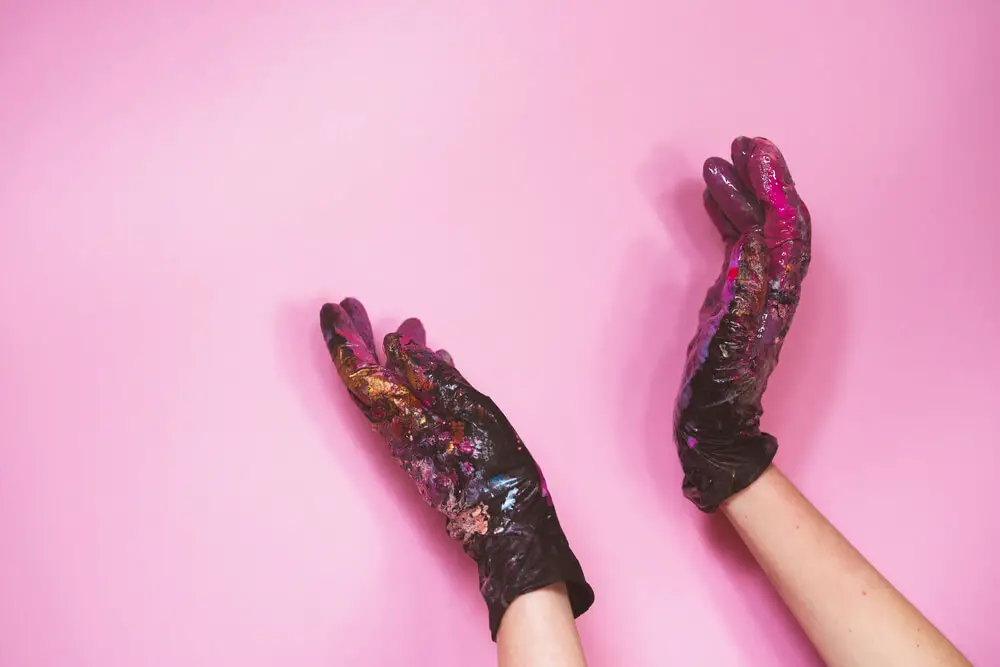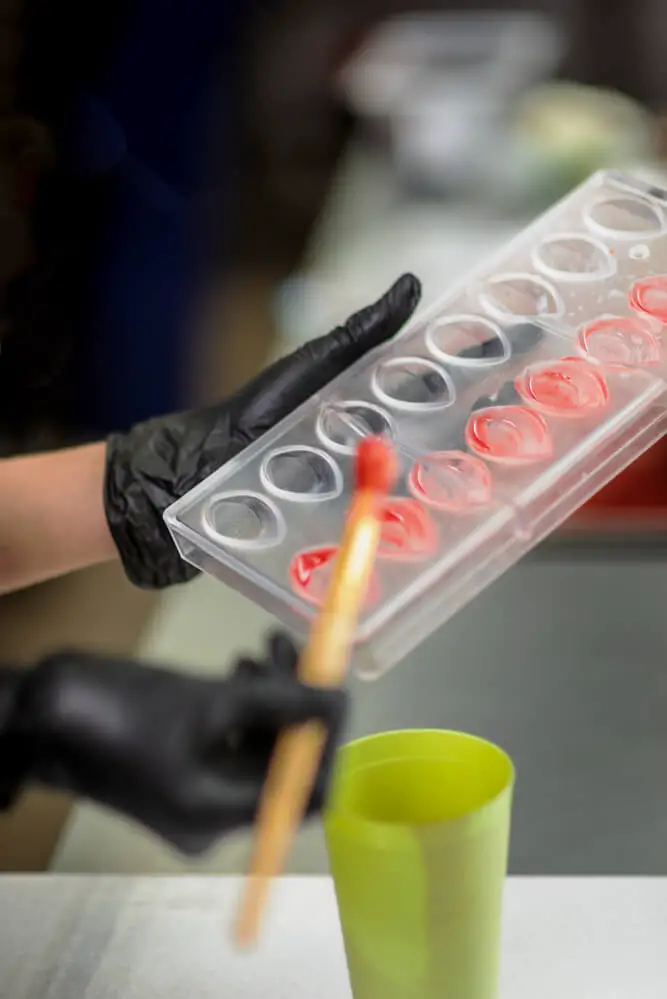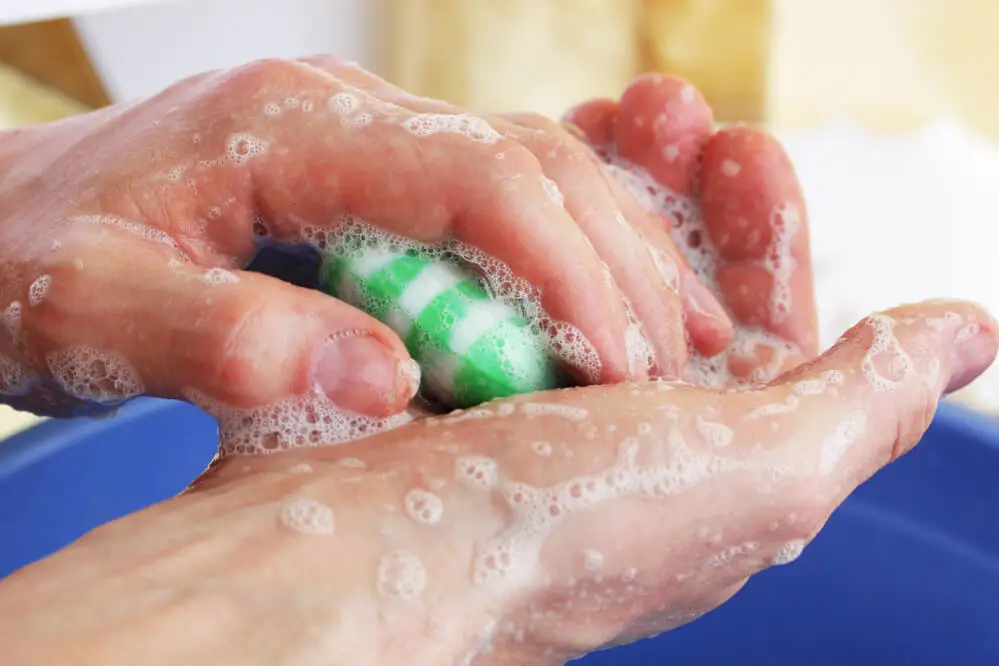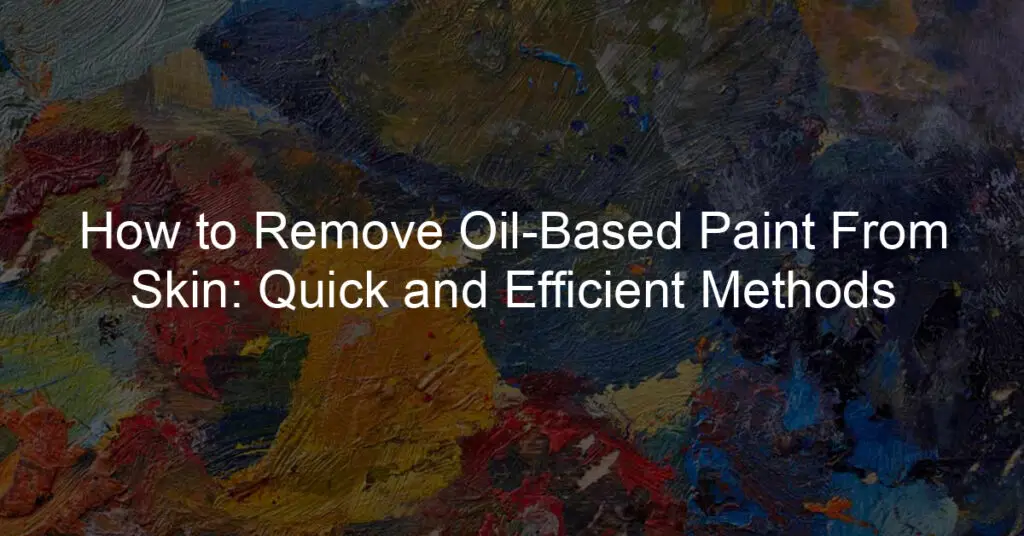When working with oil-based paint, it’s common to accidentally get some on our skin.
An important aspect of using such paints is knowing how to remove oil-based paint from skin.
Oil-based paints contain chemicals and pigments that can be difficult to remove, and it might seem like a daunting task to clean them off your skin.
Understanding the composition of oil-based paints is crucial when it comes to removing them from your skin. Their ingredients make them a bit more challenging to remove than water-based paint.
However, with a little guidance and the right technique, you can quickly rid your skin of any stubborn oil-based paint, ensuring it remains clean, healthy, and safe.
Key Takeaways
- Oil-based paint requires special care and techniques for removal from the skin.
- Acting quickly and using safe chemicals will aid in effective paint removal.
- Proper precautions and post-removal skin care can help prevent potential health hazards.
How to Remove Oil-Based Paint From Skin

In order to effectively remove oil-based paints from the skin, it’s crucial to first understand the composition of these paints.
Oil-based paints typically consist of a pigment, a binder, and a solvent. The pigment is the element that provides the color, while the binder, typically made of resins, is responsible for holding the pigment particles together and adhering them to the painted surface.
The viscosity of oil-based paints arises from the combination of the pigment, binder, and solvent. As the solvent evaporates, the binder and pigment form a solid, durable layer.
One of the key characteristics of these paints is their slower drying time compared to water-based paints, which is due to the hydrophobic nature of the oil binders.
When considering how to remove oil-based paint from the skin, it is important to know that due to the presence of oils and resins, these paints can be more stubborn and challenging to remove.
In the next section, we will outline the steps required to effectively remove oil-based paints from one’s skin without damaging the skin itself.
Why is Oil-Based Paint Difficult to Remove From Skin

One of the main reasons oil-based paint is difficult to remove from the skin is its composition. The oil content makes it resistant to water, which causes it to form a strong bond with the skin.
When I’ve tried to wash it off, I’ve found that it leaves a lingering film that can be tough to get rid of.
Another factor making it hard to remove this type of paint is that it contains various pigments and additives, which can penetrate the skin’s outer layer.
Over time, these elements can create stubborn stains that are resistant to regular cleaning methods. I’ve also noticed that oil-based paint behaves a lot like permanent markers when it comes to removal, often requiring specialized techniques or products.
However, being knowledgeable about the properties of oil-based paint allows me to better understand the tactics to tackle these challenges.
Finding the right solvents or cleaners – as well as using them carefully – can significantly increase the chances of successfully removing the paint without causing any damage to my skin.
Preemptive Measures to Avoid Skin Contact

I always recommend taking precautionary steps to minimize the chances of getting oil-based paint on your skin.
The best method is to wear protective gear, especially gloves, to shield your skin. When dealing with exterior paint or working as an artist, it’s crucial to prioritize skin protection.
To start, I choose gloves made from a material resistant to oil-based paint, such as nitrile or latex gloves. These gloves can be found in most hardware stores and will help prevent direct contact between the paint and my skin.
Further, they provide improved grip and dexterity, making it easier to work on my painting projects.
Moreover, I also take care to wear long sleeves and pants when I’m handling exterior paint. These clothing items can help protect my arms and legs from splatters and spills as I work.
It’s equally important for artists who often come into contact with oil paints or solvents during their creative process.
In case I suspect that I’ll be working with oil-based paint for an extended period, I consider applying a barrier cream to the exposed areas of my skin.
These creams create a protective layer that makes it more difficult for the paint to adhere to my skin, thus allowing for easier removal later on.
Remember, taking preemptive measures is key to minimizing the risks associated with oil-based paint on your skin.
Remembering to use gloves, protective clothing, and barrier creams when necessary, I can confidently enjoy my painting projects without worrying about harmful skin contact.
Immediate Action After Skin Contact

When I accidentally come into contact with oil-based paint, I act quickly to minimize any irritation or harm to my skin. My first step is to immediately stop what I’m doing and focus on removing the paint from my skin.
I start by gently wiping off the excess paint with a paper towel or a clean cloth, taking care not to spread it further. Once the excess paint is removed, I prepare a mixture of warm water and mild liquid soap to create soapy water.
I then wet my affected skin with warm water, taking care not to saturate the area. After wetting the skin, I apply a generous amount of the soapy water to the affected area.
I use my fingers or a soft cloth to gently scrub the paint off, working in small circular motions, paying attention to the contours of my skin.
While scrubbing, I take care not to press too hard as it may cause further irritation to my skin. If the paint doesn’t come off easily, I continue to add more soap and water, scrubbing gently until the oil-based paint is removed.
Once the paint is off, I rinse my skin thoroughly with warm water, ensuring there’s no soap or paint residue left behind. After rinsing, I gently pat my skin dry with a clean towel.
Advanced Techniques for Oil Paint Removal

Using Household Ingredients
I have found that there are several household ingredients that can effectively remove oil-based paint from the skin.
One option is to create a salt scrub by combining equal parts salt and vegetable oil, such as olive oil or coconut oil.
This mixture gently exfoliates the skin, helping remove paint stains. Gently rub the scrub onto the affected area until the paint comes off, then wash with soap and water.
Another option is to use mayonnaise, which contains oil and glycerin that work to break down and dissolve the paint.
Apply a generous amount of mayonnaise directly onto the paint stain, wait a few minutes for it to break down the paint, and then gently rub it away. Wash with soap and water to remove any residue.
For stubborn stains, a mixture of baking soda and a mild dish soap can do the trick. The abrasive nature of the baking soda helps to remove the paint, and the dish soap further dissolves it.
Mix equal parts baking soda and dish soap, apply to the paint stain, and rub gently until the paint comes off. Rinse with water to remove any leftover residue.
Using Commercial Solvents
If household ingredients don’t seem to do the trick, there are commercial solvents that can effectively remove oil-based paint from the skin.
Mineral spirits paint thinner, and turpentine are all strong solvents that can break down and dissolve the paint.
Yet, these solvents can be harsh on the skin, so be sure to use them sparingly and only as a last resort.
Before using any commercial solvent, make sure to test a small amount on an inconspicuous area of your skin to ensure there are no adverse reactions.
To use, dab a small amount of the solvent onto a cloth or cotton ball and gently rub it onto the paint stain until it dissolves.
Rinse the area with water and wash with soap afterward to remove any residue.
Another option is to use rubbing alcohol, nail polish remover, or even baby oil. These products are less harsh on the skin and can still effectively remove oil-based paint.
Apply a small amount of the chosen product onto a cloth or cotton ball and gently rub it onto the paint stain until it comes off.
Be sure to rinse the area with water and wash with soap afterward.
Remember, when dealing with oil-based paint stains, it’s essential to act quickly and avoid allowing the paint to dry on your skin.
Using these advanced techniques utilizing household ingredients or commercial solvents can effectively remove oil-based paint from your skin.
Post-Removal Skin Care

After successfully removing the oil-based paint from my skin, it’s essential to take proper care of the area to prevent irritation and promote healing.
I always make sure to cleanse my skin gently with a mild soap and warm water to remove any remaining residue.
It’s important for me to apply a moisturizer to the affected area, as the removal process may leave my skin dry and sensitive.
I prefer using a fragrance-free and gentle moisturizer, and I apply a generous amount on the skin using a cotton ball.
This helps to restore hydration and soothe any irritation that may have been caused during the paint removal process.
Besides moisturizing, I also pay close attention to any signs of skin reactions or irritation. If I notice any unusual symptoms, such as redness, swelling, or itching, it’s crucial for me to consult a dermatologist.
They can provide the necessary guidance and recommendations regarding further treatment or care required for my skin.
In addition, I make sure to protect the affected area from direct sunlight exposure and harsh chemicals for a few days.
Wearing gloves when handling cleaning products and applying sunscreen if I need to step out in the sun can go a long way in ensuring proper skin care post-oil-based paint removal.
Potential Health Hazards of Oil-Based Paint on Skin
As someone who handles oil-based paint on a regular basis, I know first-hand the potential health hazards it presents.
One major concern with oil-based paint is that it contains a variety of toxic chemicals. These chemicals can be harmful, especially if you accidentally get the paint on your skin.
Exposure to the toxic elements in oil-based paints can lead to various health issues, such as irritation and inflammation of the skin.
This irritation can be quite uncomfortable and can even progress to a more severe skin infection if not properly addressed.
Moreover, when working with oil-based paints, it’s essential to be aware of the toxic fumes that might be released.
These fumes can be highly dangerous if you inhale them, and they might cause respiratory issues in some individuals.
Another significant health risk associated with the use of oil-based paints is their potential link to cancer. Some of the chemicals found in these paints, such as benzene and formaldehyde, are known carcinogens.
Although the risk of developing cancer from occasional exposure to oil-based paints is relatively low, I believe it’s crucial to be mindful of the potential dangers and take necessary precautions.
When working with oil-based paint, I always try to be vigilant about the potential health risks and prioritize my safety and well-being, especially regarding skin contact, toxic fumes, and possible long-term effects.
I find it worthwhile to invest in proper personal protective equipment and follow best practices to reduce the risks associated with this type of paint.
Exploring Alternatives to Oil-Based Paint

As a painter, I know that oil-based paints can sometimes be difficult to remove from the skin. Fortunately, there are alternative options available, such as water-based paints.
These alternatives are not only easier to clean up but also more environmentally friendly.
One alternative to oil-based paint is acrylic paint, a water-based paint that is generally easier to remove from the skin.
Acrylics dry quickly and can often be cleaned up with just soap and water, making them a popular choice for artists and DIY enthusiasts alike.
These paints have vibrant colors and excellent longevity, making them a viable option for many painting projects.
Another alternative is latex paint, also a water-based paint that cleans up easily with water. Latex paints are known for their durability and resistance to moisture, which makes them suitable for both indoor and outdoor use.
Their low odor and low levels of toxic emissions also contribute to a healthier painting environment.
Water-based paints such as acrylic and latex paints are excellent alternatives to oil-based paints. They provide a range of benefits, including easier cleanup, reduced environmental impact, and a wide range of uses.
Opting for these alternatives can enjoy the process of painting with a clear conscience and cleaner hands.
Summarizing Key Points to Remember
When it comes to removing oil-based paint from my skin, I want to note a few crucial tips and techniques.
Firstly, I should always have a clean-up plan ready before starting any paint job, as accidents are inevitable.
A popular solution to loosen oil-based paint is using Vicks VapoRub, thanks to its petroleum base.
By gently massaging it onto the affected area of my skin, the paint starts to break down, allowing me to wipe it off with a cloth or paper towel.
Another interesting household remedy is sugar. Gently rubbing a tablespoon of sugar onto the stained area of my skin helps in dissolving the paint. While using sugar, I want to make sure I don’t scrub too hard to avoid skin irritation.
It’s essential to remember that removing oil-based paint from my skin may take multiple attempts. Thoroughly washing and rinsing the area with non-abrasive soap and water between attempts is a good practice.
In summary, I must keep a clean-up plan and try various removal techniques like Vicks VapoRub or sugar while never forgetting to stay persistent with multiple tries if needed.
This way, I can confidently and efficiently remove oil-based paint from my skin without causing any harm.
Frequently Asked Questions
What is the best way to remove oil-based paint from skin?
In my experience, using a specialized paint remover or oil-based cleanser works well for removing oil-based paint from skin without causing irritation.
Simply apply the remover or cleanser to the affected area and gently rub it in using a soft cloth or sponge. Rinse the area with warm water and repeat if necessary. Remember to moisturize your skin after the process to avoid dryness.
Is it safe to use rubbing alcohol to remove oil paint?
Yes, it’s generally safe to use rubbing alcohol to remove oil paint from skin. Nevertheless, be cautious if you have sensitive skin, as rubbing alcohol can dry and potentially irritate your skin.
Make sure to apply a moisturizer after using rubbing alcohol to keep your skin hydrated.
Can hand sanitizer be used to remove oil-based paint from hands?
Hand sanitizer can help to some extent, especially if it contains alcohol. Apply a generous amount of hand sanitizer to the paint-covered area and rub it in, then rinse your hands with warm water.
This method may not be as effective as using a specialized cleanser, but it can be a convenient option when you don’t have access to other materials.
What household items can help get paint off skin?
Many household items can be used to remove oil-based paint from skin. These include vegetable or olive oil, baby oil, and even butter or mayonnaise.
Just make sure to wash your skin well afterward with soap and water to remove any residue.
Are there any risks associated with oil paint on skin?
Oil paint itself is not usually harmful if it comes in contact with your skin. Regardless, prolonged or frequent exposure to oil paint, especially if it contains harmful additives or solvents, can cause skin irritation or allergic reactions.
Always use gloves and other protective gear while working with oil paints to minimize potential risks.
How can I remove oil-based paint from skin without causing irritation?
To remove oil-based paint from your skin without causing irritation, I recommend using a gentle oil-based cleanser or paint remover that’s specifically designed for this purpose.
Apply the cleanser to the affected area and gently rub it, then rinse your skin with warm water. Repeat the process if necessary and moisturize your skin afterward.
Always use caution when handling oil-based paints, and try to avoid getting them on your skin as much as possible.


















